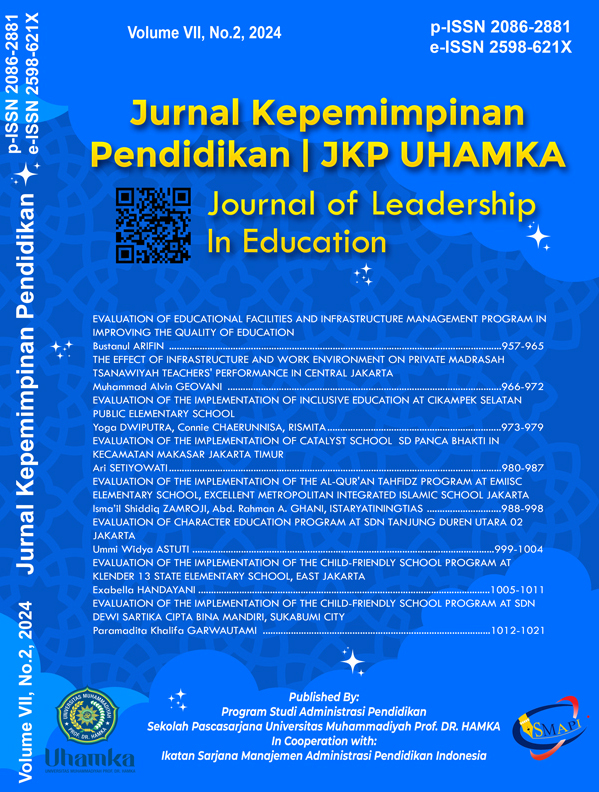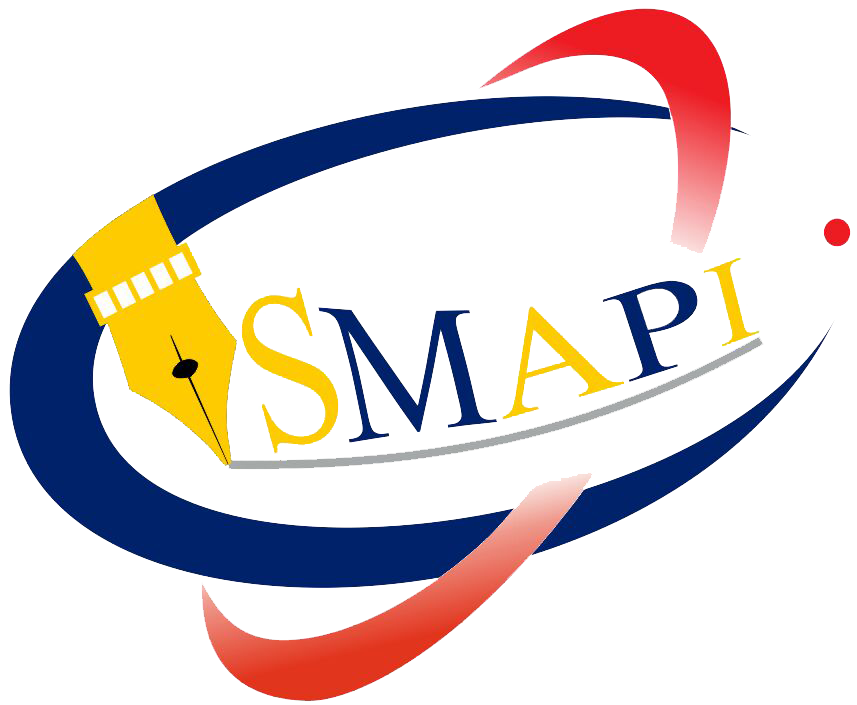EVALUATION OF EDUCATIONAL FACILITIES AND INFRASTRUCTURE MANAGEMENT PROGRAM IN IMPROVING THE QUALITY OF EDUCATION
DOI:
https://doi.org/10.22236/jkpuhamka.v7i2.18224Keywords:
Management, Facilities, Infrastructure, Education QualityAbstract
Facilities and infrastructure are crucial in supporting the smooth learning process. The teaching and learning process can run effectively with adequate facilities and infrastructure. This study aims to analyze and evaluate the management of educational facilities and infrastructure to improve the quality of education. This research uses a qualitative approach with an evaluation method through the discrepancy model. The study was conducted at SDIT Daar El Khaer, Tigaraksa, Tangerang, involving 5 research subjects: the principal, the head of facilities and infrastructure, the school committee, students, and parents. Data were collected through observation, interviews, and documentation. The results show that the management of facilities and infrastructure complies with regulations and meets students’ needs, although bureaucratic obstacles remain. Facilities and infrastructure that meet government standards account for only 50%-55%. Therefore, schools must focus on managing facilities and infrastructure effectively and streamline bureaucratic processes to meet students' needs according to official standards. This study recommends that the facilities and infrastructure program at SDIT Daar El Khaer be continued while adhering to the latest standards based on Government Regulation No. 57 of 2021 and Minister of Education, Culture, Research, and Technology Regulations No. 22 and 48 of 2023. The implementation must involve all relevant parties, including the school committee. The principal should oversee the implementation of facilities standards by the head of facilities. Schools need to evaluate bureaucratic obstacles, find solutions to improve efficiency, and continuously monitor and enhance their facilities according to regulations to improve educational quality.
Downloads
References
Akareem, H. S., & Hossain, S. S. (2012). Perception of education quality in private universities of Bangladesh: A study from students’ perspective. Journal of Marketing for Higher Education, 22(1), 11–33. https://doi.org/10.1080/08841241.2012.705792
Akhihiero, E. T. (2011). Effect of inadequate infrastructural facilities on academic performance of students of Oredo local government area of Edo state. Paper Presented at The Nigerian Academic Forum.
Alkadri, H., Ningrum, T. A., Santoso, Y., & Afriansyah, H. (2018). Essentiality of management of facilities and infrastructure toward a number of students of early years institution. Proceedings of the International Conference of Early Childhood Education (ICECE 2017). https://doi.org/10.2991/icece-17.2018.18
Ayeni, A. J., & Adelabu, M. A. (2011). Improving learning infrastructure and environment for sustainable quality assurance practice in secondary schools in Ondo State, South-West, Nigeria. International Journal of Research Studies in Education, 1(1), 62–68. https://doi.org/10.5861/ijrse.2012.v1i1.20
Bandono, W. A., & Samino. (2015). Pengelolaan Sarana Dan Prasarana Di Sekolah Dasar Negeri 01 Tohudan, Karanganyar. Profesi Dasar, 2(1), 41–48.
Ershadi, M. M., & Shemirani, H. S. (2020). Simulation and optimization for improving performance of maintenance. Facilities, 39(5/6), 256–276. https://doi.org/10.1108/F-08-2019-0083
Green, D., & Turrell, P. (2005). School building investment and impact on pupil performance. Facilities, 23(5/6), 253–261. https://doi.org/10.1108/02632770510588655
Hamalik, O. (2011). Proses Belajar Mengajar. Jakarta: Bumi Aksara.
Herwan, H., Aswandi, A., & Chiar, M. (2018). The role of school committee in supporting the fulfillment of education facilities and infrastructure. JETL: Journal of Education, Teaching and Learning, 3(2), 282. https://doi.org/10.26737/jetl.v3i2.763
Kuuskorpi, M., & Gonzalez, N. C. (2011). The future of the phisical learning environment: School facilities that support the user. CELE Exchange 2011/11. OECD. https://www.oecd-ilibrary.org/docserver/5kg0lkz2d9f2en.pdf?expires=1639646540&id=id&accname=guest&checksum=D21122688EF70D86E45CBC9456EE8B68
Lynch, D., Smith, R., Yeigh, T., & Provost, S. (2019). A study into 'organisational readiness' and its impacts on school improvement. International Journal https://doi.org/10.1108/IJEM-07-2017-0181
Mahmud, D. (2001). Psikologi Suatu Pengantar. Jakarta: Dependikbud.
Marmoah, S., Adela, D., & Fauziah, M. (2019). Implementation of facilities and infrastructure management in public elementary schools. AL-Tanzim : Jurnal Manajemen Pendidikan Islam, 3(1), 102–134. https://doi.org/10.33650/al-tanzim.v3i1.507
Ngwaru, J. M., & Oluga, M. (2015). Educational infrastructure and resources for sustainable access to schooling and outcomes: The case of early literacy development in southern Tanzania. Africa Education Review, 12(1), 88–108. https://doi.org/10.1080/18146627.2015.1036570
Petilo, J. T. (2024). Educational Facilities Cross Evaluation in Compliance with Sustainable Development Goals (SDG) 4. A. 1. Online Submission.
PSA. (2023). SDG INDICATOR. Philippine Statistic Office. Retrieved June 7, 2023, from https://openstat.psa.gov.ph/Featured/National-Database-on-Child-Poverty/Sustainable-Development-Goals-Goal-4
Ruhyana, N. F., & Aeni, A. N. (2019, April). Effect of Educational Facilities and Infrastructure in Primary Schools on Students' Learning Outcomes. In Elementary School Forum (Mimbar Sekolah Dasar) (Vol. 6, No. 1, pp. 43-54). Indonesia University of Education.
Siregar, N., & Aziza, S. (2021). Optimization of facilities and infrastructure management in improving the quality of learning. Jurnal Tarbiyah, 28(1), 30. https://doi.org/10.30829/tar.v28i1.905
Slameto. (2010). Belajar dan Faktor-Faktor yang Mempengaruhi. Jakarta: Rineka Cipta.
Souck, E. N., & Nji, G. (2017). The effects of school facilities on internal efficiency: The case of selected bilingual secondary schools in yaounde centre. World Journal of Research and Review (WJRR), 4(4), 41–48. https://www.neliti.com/id/publications/262822/the-effects-of-school-facilities-on-internal-efficiency-thecase-of-selected-bil
Sulasteri, S., Nur, F., & Suharti, S. (2021). The effect of computer laboratory facilities and learning interest on students’ learning outcome. Kreano: Jurnal Matematika Kreatif-Inovatif, 12(1), 97–106. https://doi.org/10.15294/kreano.v12i1.27735
Syah, M. (2013). Psikologi Pendidikan. Bandung: Remaja Rosdakarya.
Tazkia, S. R., & Suherman, A. (2016). Optimizing practice tools facilities to achieve competency demands for vocational high school students. Journal of Mechanical Engineering Education, 3(2), 263. https://doi.org/10.17509/jmee.v3i2.4560
Ugwulashi, C. S. (2017). Educational facilities: Appropriate strategy for school safety management in rivers state, Nigeria. International Journal of Academic Research in Progressive Education and Development, 6(2). https://doi.org/10.6007/IJARPED/v6-i2/2933
Vincent, J. M. (2012). California’s K-12 educational infrastructure investments: Leveraging the state’s role for quality school facilities in sustainable communities. A policy research report to the California Department of Education. Center for Cities & Schools.
Wagner, D. A. (2010). Quality of education, comparability, and assessment choice in developing countries. Compare: A Journal of Comparative https://doi.org/10.1080/03057925.2010.523231
Downloads
Published
How to Cite
Issue
Section
License
Copyright (c) 2025 Bustanul ARIFIN

This work is licensed under a Creative Commons Attribution 4.0 International License.















